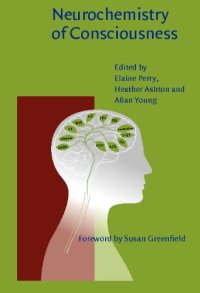
Ebook: Neurochemistry of Consciousness: Neurotransmitters in Mind
- Genre: Chemistry
- Series: Advances in Consciousness Research 36
- Year: 2002
- Publisher: John Benjamins Publishing Company
- Language: English
- pdf
The book gives a good introduction to the major systems that irrigate the cortex with neuromodulators and neurotransmitters, like noradrenalin, serotonin, dopamine, acetycholine, etc. It is telling even here that most nuclei involved are in or arround the reticular activating system (raphe, meyenert, caudate), a structure long impicated with consciousness (even if only as a necessary condition of activation). There is a chapter on what is to me the most plausible quantum model of consciousness (but I remain sceptic), by N. Woolf, and proposes that acetycholine regulates proteins that bind to microtubules making these apt for quantum coherence (if this sounds complicated, it is).
The first section deals witj neurochemistry of memory, attention,spleep, dreaming, etc..., issues that obviously relate to consciousness in important ways. Attention for example, is to most essential to consciousness, given that unattended stimuli seem to not become conscious, whereas attended ones invariably seem to. Sleep is obviously a good paradigm for studying consciousness, given that it is characterized by changes in the conscious state itself. If we understood everything about sleep, we would be a long way into understanding consciousness.
The second chapter deals with how chemicals affect consciousness. Here I beliieve, anaesthethics are of primary importance. There is a chapter on anaesthesia, on neuroleptics, on drugs and plants that have them, etc.. Anaesthethics seem to abolish consciousness, so finding out why would at the very least tell us the necessary conditions for consciousness to occur. The papers on this section illustrate the role some neurochemicals might have in the regulation of the conscious state, as well as how when malfunctioning these can have effects on the conscious state. The last chapter deals with brain diseases, (altzheimers, lewey bodies, schizofrenia, mood-disorders, autism), their probably chemical substrates, and how understanding them not only could bring relief to sufferers of these disorders, but illuminate the mechanisms of consciousness.
All in all, this is a wonderful book, and everyone that reads it will not think of consciousness again without including brain neurochemistry into the picture. It is clear that consicousness will only be fully understood when we have its neural correlates, its neurochemical correlates, its functional correlates, and a way to translate all this into a phenomenal language. This book is then an attempt into puting together one quarter of the puzzle. (For another half of the puzzle, see NCC by T. Metzinger, The Cognitive Neuroscience of Consciousness, by S. Dehaene,In The Theather of Consciousness by Bernard Baars. Unfortunately, the last quarter of the puzzle, qualia, lacks a good representative in the literature. try Humphreys How to Solve the Mind-Body Problem, or maybe Carrunthers, Phenomenal Consciousness.)